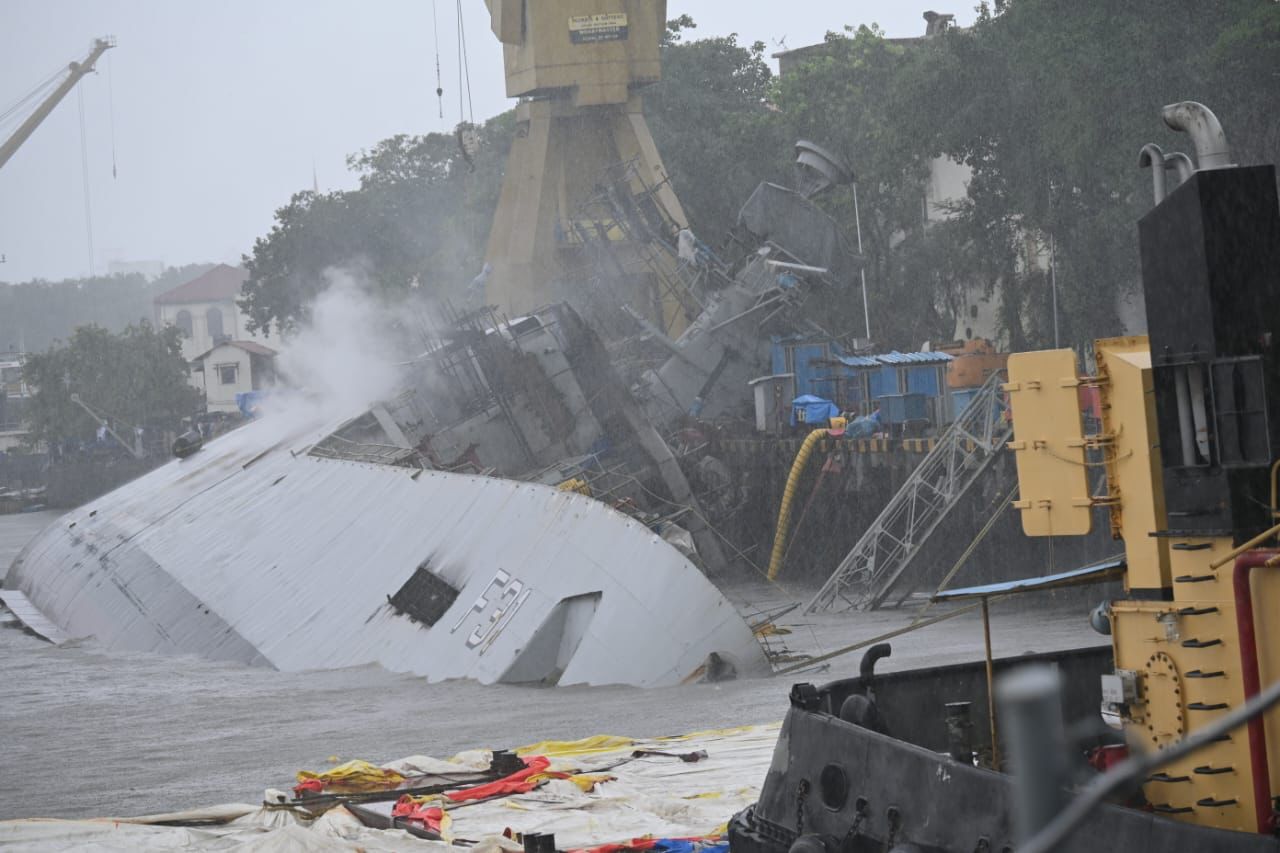The spate of ill-fated accidents on board Indian Navy warships continues. On July 21, the Brahmaputra class of multi-role frigate INS Brahmaputra started listing to one side after getting severely damaged in a fire incident.
This is the second warship of the same class to have suffered an accident in the dockyard. In 2016, INS Betwa tipped over and crashed onto its side during undocking at the Naval Dockyard in Mumbai.
The Indian Navy has ordered an inquiry into the accident. According to initial reports, a fire broke out onboard the Indian Naval Ship Brahmaputra, a multi-role Frigate, on the evening of July 21 while she was undergoing refit. The fire was brought under control by the ship’s crew, with the assistance of firefighters from the Naval Dockyard, Mumbai, and other ships in the harbor, by the morning of July 22.
In a statement, the Indian Navy said: “In the fire incident onboard the frigate INS Brahmaputra, the warship experienced severe listing to one side (port side). Despite all efforts, the ship could not be brought to an upright position. The ship continued to list further alongside her berth and is presently resting on one side.” All personnel have been accounted for except one junior sailor, for whom the search is in progress.
Looking at the state of the warship, it seems highly unlikely that it can be salvaged.
INS Brahmaputra, the first of the indigenously built ‘Brahmaputra’ class-guided missile frigates. The ship is fitted with an array of weapons, including surface-to-surface missiles, surface-to-air missiles, medium-range guns, anti-submarine rockets, radars, sonars, and electronic warfare systems.
In 2006, during Operation Sukoon, INS Brahmaputra played a crucial role in evacuating Indian nationals from Lebanon during the Israel-Hezbollah conflict. The ship was part of Task Force 54, which monitored the conflict and ensured the safety of remaining Indian citizens in Lebanon.

Eight years earlier, during the undocking, INS Betwa tipped over, tragically losing two sailors and injuring 14 others. The ship’s main mast, which has crucial sensors, was damaged during the accident.
In January 2014, INS Betwa had previously run aground and collided with an unidentified object while approaching the Mumbai Naval base.
In 2019, the Navy started a general court-martial against three of its senior officials after they were found guilty of dereliction of duties by a high-level inquiry panel probing the first-of-its-kind accident involving the frontline warship. The warship was repaired and made sail-worthy.
The year 2014 was unfortunate for the Indian Navy. Another of its tank-landing ships, INS Airavat, ran aground in Vishakapatanam, and its propellers were badly damaged.
In September 2013, a fire broke out on India’s only aircraft carrier, INS Viraat, off the coast of Mumbai.
In 2011, the frigate INS Vindhyagiri sank at her berth after a major collision. On January 30, 2011, INS Vindhyagiri, entering the Mumbai dockyard, was involved in a collision with MV Nordlake, a Cyprus-flagged container carrier that was moving out of the harbor. INS Vindhyagiri caught fire and capsized. She was raised only to be sailed out and used as target practice.
$2.9B Nuclear Submarine Accident
India’s first indigenously developed nuclear-powered ballistic submarine, INS Arihant, was out of operation in 2017 after an aft hatch was left often while the submarine was docked.
Saltwater flooded the propulsion area, rendering the submarine inoperative for 10 months. It was then sent for repairs. The submarine is powered by an 83 MW pressurized light-water reactor with enriched uranium.
Arihant is a strategic platform to complete India’s nuclear triad. It serves as the country’s strategic strike nuclear submarine. The submarine was restored to its operational status and deployed in 2018.
The incident on board Arihant happened soon after INS Chakra, the Nerpa class nuclear submarine leased from Russia, was reported to have suffered damage to its sonar domes while entering the Visakhapatnam harbor in October 2017.
However, INS Chakra has only a training and escorting role in the nuclear triad. INS Arihant is the one that will carry nuclear missiles.
Arihant is based on the Russian Akula-1 class nuclear attack submarine. The Russian submarine was lengthened to accommodate twelve K-15 short-range nuclear missiles or four K-4 intermediate-range nuclear missiles.
K-15 missiles, with their 434-mile range, are primarily meant to target Pakistan, while K-4 missiles, with their 2,174-mile range, can reach all of Pakistan and as far as the capital of India’s other adversary, Beijing.
Navy Chief Resigned After A Slew Of Accidents
In February 2014, then-Indian Navy chief Admiral DK Joshi resigned after the 10th accident involving an Indian warship in seven months.
The trigger was the accident involving the Russian kilo-class submarine Sindhuratna. INS Sindhuratna was forced to surface after smoke was detected on board. Seven crew members were airlifted from the submarine and admitted to a hospital in Mumbai. Two other crew members were missing.
After the accident, Admiral D K Joshi submitted his resignation, “taking moral responsibility for the accidents and incidents which have taken place during the past few months.”
The fire onboard Sindhuratna came six months after another Russian-made submarine, INS Sindhurakshak, exploded and sank while docked in Mumbai, killing 18 crew members. It was the worst maritime loss in India in four decades.
The incidents involving INS Betwa and INS Airawat also happened under his command.
Delays in the acquisition of new submarines, coupled with a deficient and aging fleet of submarines, are affecting the Indian Navy’s operational capabilities.
In addition, the Indian Navy’s deployment has increased in recent years as it reinforces its role as the first responder in the Indian Ocean Region and assumes a pivotal role in international maritime security. Accidents are bound to happen; however, safety protocols should be put in place following thorough investigations.
- Ritu Sharma has been a journalist for over a decade, writing on defense, foreign affairs, and nuclear technology.
- The author can be reached at ritu.sharma (at) mail.com
- Follow EurAsian Times on Google News




